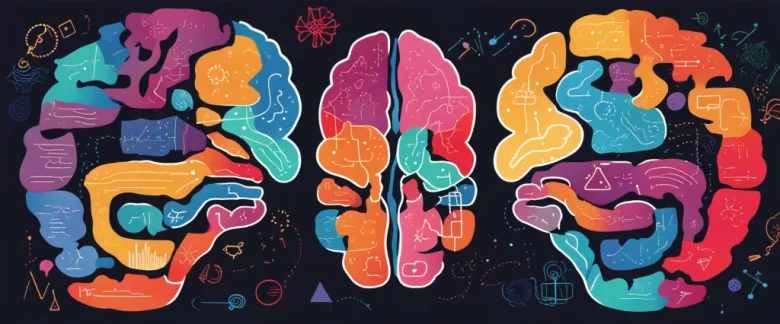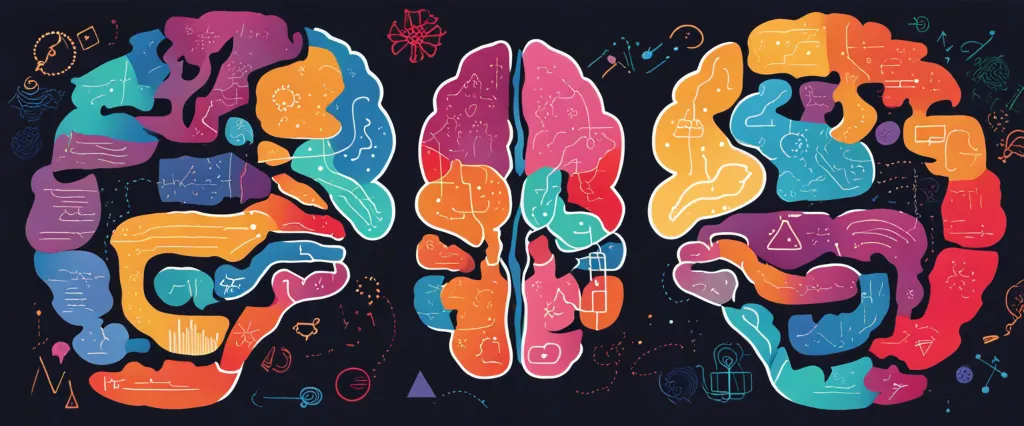In “Divergent Mind,” author Jenara Nerenberg explores the fascinating world of neurodiversity, shedding light on the experiences of those with atypical minds. As an esteemed writer and researcher, Nerenberg delves into the lives of remarkable individuals who are neurodivergent, celebrating their unique abilities and offering insights into how society can better embrace and accommodate their differences. By challenging conventional notions of intelligence and normalcy, this thought-provoking book encourages us to value the diverse cognitive pathways that exist and ultimately promotes a more inclusive and compassionate world.
Chapter 1: The Power of Divergent Thinking
Chapter 1: The Power of Divergent Thinking of the book “Divergent Mind” by Jenara Nerenberg explores the concept of divergent thinking and its significance in our society. The chapter introduces the author’s journey into understanding and celebrating neurodiversity, highlighting the importance of divergent thinking as a powerful tool for innovation and problem-solving.
Nerenberg begins by explaining that divergent thinking refers to the ability to generate multiple perspectives, ideas, and solutions to a given problem. It is a cognitive process that allows individuals to think outside the box, make connections between seemingly unrelated concepts, and challenge existing norms. Unlike convergent thinking, which is focused on finding a single correct answer, divergent thinking encourages the exploration of multiple possibilities.
The author emphasizes the immense value of divergent thinking in today’s rapidly changing world. She argues that our education systems and workplaces often prioritize conformity and linear thinking, which limit creativity and hinder progress. By embracing divergent thinking, we can tap into the collective creativity of neurodivergent individuals and cultivate innovative solutions to complex challenges.
Nerenberg shares personal stories and interviews with experts and neurodiverse individuals who have harnessed the power of divergent thinking to achieve remarkable accomplishments in various fields. She discusses how divergent thinking has fueled breakthroughs in technology, art, and science, demonstrating its transformative potential.
Furthermore, the chapter challenges the stigma and misconceptions surrounding neurodivergent individuals, such as those with autism, ADHD, or dyslexia. It highlights their unique cognitive strengths and suggests that society should embrace and celebrate neurodiversity rather than considering these individuals as outliers.
In summary, Chapter 1 of “Divergent Mind” explores the essence of divergent thinking and its significance in fostering innovation and embracing neurodiversity. Nerenberg encourages readers to develop and appreciate divergent thinking as a powerful tool for shaping a more inclusive and creative society.
Chapter 2: Understanding and Embracing Different Thinking Styles
Chapter 2 of “Divergent Mind” by Jenara Nerenberg focuses on understanding and embracing different thinking styles. The author emphasizes that society often pushes individuals to conform to a single standard of thinking, which overlooks and marginalizes the unique cognitive abilities of neurodivergent people.
Nerenberg introduces the concept of neurodiversity, which recognizes that neurological differences, such as autism, ADHD, dyslexia, and others, are natural variations of the human brain rather than disorders. She explains that these divergent minds possess distinct strengths and talents that can be valuable to individuals and society as a whole.
The chapter explores various thinking styles, highlighting the strengths and challenges associated with each. For instance, individuals with hyperfocus, often found in people with ADHD or autism, possess an exceptional ability to concentrate on specific tasks for extended periods. However, this strength may result in difficulty shifting attention or multitasking.
Nerenberg also explores the role of intuition, imagination, and pattern recognition in divergent thinking. She explains that many neurodivergent individuals excel in these areas, allowing them to connect seemingly unrelated concepts and think outside the box. However, society often dismisses these unconventional approaches in favor of linear and logical thinking.
The chapter concludes by urging readers to recognize and appreciate the diverse thinking styles within themselves and others. Nerenberg emphasizes the importance of embracing cognitive differences to foster innovation and creativity in various fields. By understanding and valuing neurodiversity, society can create an inclusive environment that benefits everyone, regardless of their thinking style.
Chapter 3: Developing and Nurturing Creative Thinking
Chapter 3 of “Divergent Mind” by Jenara Nerenberg focuses on the development and nurturing of creative thinking. The chapter begins by highlighting the importance of creativity in our lives and the benefits it brings to individuals and society as a whole.
Nerenberg emphasizes that creativity is not limited to artistic talent; instead, it can be applied to problem-solving, innovation, and critical thinking in various domains. She explores the misconception that creative thinking is inherent and cannot be cultivated, emphasizing that everyone has the potential to think creatively.
The author provides insights into the neuroscience behind creativity, discussing brain regions and neural networks involved in generating novel ideas. Nerenberg reveals that creativity requires a combination of focused attention, diffuse attention, and mindfulness. She introduces the concept of divergent thinking, which involves generating multiple ideas and possible solutions, as opposed to convergent thinking that focuses on finding a single solution.
Nerenberg offers practical tips on how to foster creative thinking, including engaging in activities that inspire curiosity, embracing complexity, and finding solutions through trial and error. She suggests cultivating an open mindset, seeking diverse perspectives, and encouraging unconventional connections by actively challenging one’s assumptions and biases.
Additionally, the chapter emphasizes the importance of creating an enabling environment for creative thinking. Nerenberg explores the role of education, workplace culture, and societal norms in promoting or stifling creativity. The author advocates for the integration of playful and exploratory approaches into education systems to foster creative thinking from a young age.
In summary, Chapter 3 of “Divergent Mind” provides valuable insights into the development and nurturing of creative thinking. Nerenberg dispels the myth that creativity is an inherent trait and offers practical suggestions for cultivating creative thinking, while also highlighting the significance of an environment that supports and values creativity.
Chapter 4: The Advantages and Applications of Divergent Thinking

Chapter 4 of “Divergent Mind” by Jenara Nerenberg explores the numerous advantages and applications of divergent thinking. The author begins by highlighting the importance of divergent thinking in fostering creativity, problem-solving skills, and the ability to think outside the box.
Nerenberg describes how divergent thinkers possess a greater capacity for generating multiple solutions to a single problem, rather than adhering to conventional approaches. This flexibility of thought allows them to explore various possibilities and uncover innovative solutions that others may overlook. The chapter then delves into the influence of divergent thinking on the fields of science, arts, entrepreneurship, and education.
In the scientific realm, divergent thinking enables researchers to develop new hypotheses, question established theories, and explore uncharted territories. It encourages interdisciplinary collaboration, as divergent thinkers bring fresh perspectives and unique insights to the table.
In the arts, divergent thinking flourishes as artists often challenge the status quo, pushing the boundaries of creativity and expression. The author highlights the work of divergent thinkers such as Salvador Dali and Maya Angelou to showcase their extraordinary contributions stemming from their divergent minds.
Entrepreneurship, too, greatly benefits from divergent thinking. Innovators with divergent minds can identify gaps in the market and develop novel products or services. They have the versatility to pivot and adapt to changing circumstances, allowing them to succeed in an ever-evolving business landscape.
Lastly, the chapter emphasizes the transformative potential of divergent thinking in education. Traditional educational systems primarily focus on convergent thinking, which narrows down possibilities to a single, correct answer. However, fostering divergent thinking in schools encourages students to explore ideas, engage in creative problem-solving, and embrace individuality.
In summary, Chapter 4 illustrates the advantages and applications of divergent thinking across various domains. By encouraging open-mindedness, flexibility, and originality, divergent thinking paves the way for innovation, creativity, and success in science, arts, entrepreneurship, and education.
Chapter 5: Empowering Innovation and Change
Chapter 5 of “Divergent Mind” by Jenara Nerenberg explores the concept of empowering innovation and change in the context of neurodiversity. The chapter emphasizes the importance of fostering environments that allow individuals with neurodivergent minds to thrive and contribute their unique perspectives.
Nerenberg begins by discussing the limitations of traditional organizational structures and practices, which often stifle innovation by promoting conformity and discouraging divergent thinking. She argues that embracing neurodiversity can fuel creativity and lead to breakthroughs in various fields. By accepting and accommodating different cognitive styles, organizations can tap into the untapped potential of neurodivergent individuals and foster a culture of inclusion.
The chapter also focuses on the role of empathy in driving change. Nerenberg suggests that developing empathy for the experiences and challenges faced by neurodivergent individuals is crucial for creating supportive environments. She encourages readers to challenge stereotypes and biases surrounding neurodiversity, promoting a better understanding of the unique strengths and abilities that neurodivergent individuals bring to the table.
Furthermore, Nerenberg provides practical strategies for empowering innovation and change within organizations. She emphasizes the importance of creating safe spaces for neurodivergent individuals to express their ideas and contribute to decision-making processes. This involves shifting the focus from conformity to diversity, valuing different thinking styles, and providing necessary accommodations to support neurodivergent employees.
Overall, Chapter 5 of “Divergent Mind” advocates for embracing neurodiversity as a driving force for innovation and change. It highlights the potential of neurodivergent individuals and provides guidance on creating environments where they can thrive and make meaningful contributions.
Chapter 6: Expanding the Boundaries of Thinking
Chapter 6 of “Divergent Mind” by Jenara Nerenberg explores the concept of expanding the boundaries of thinking. The chapter primarily focuses on the importance of embracing diverse perspectives and challenging traditional thought patterns to foster creativity and innovation.
Nerenberg begins by emphasizing the need to cultivate a growth mindset, which encourages individuals to view challenges as learning opportunities rather than obstacles. By embracing a growth mindset, individuals can expand their thinking by continuously seeking new experiences and pushing their boundaries.
The author also discusses the value of interdisciplinary thinking, encouraging readers to venture beyond their own domains and explore knowledge and ideas from diverse disciplines. By integrating concepts and insights from different areas, individuals can develop more holistic and innovative solutions to complex problems.
Nerenberg further emphasizes the significance of empathy and perspective-taking in expanding thinking. Understanding and considering others’ viewpoints not only fosters better interpersonal relationships but also broadens one’s own thinking and promotes creativity. By actively practicing empathy, individuals can stretch their comfort zones and challenge their assumptions.
The chapter also delves into the power of curiosity and questioning. Nerenberg highlights the importance of asking critical questions and not settling for easy, surface-level answers. She explains that curiosity encourages exploration and continuous learning, which ultimately leads to expanding one’s intellectual boundaries.
Furthermore, the chapter emphasizes the value of cultivating an open mind and embracing ambiguity. Nerenberg encourages readers to challenge binary thinking and embrace nuance, as this allows for more complex and comprehensive understanding of various subjects.
In conclusion, Chapter 6 of “Divergent Mind” highlights the significance of expanding one’s thinking by embracing diverse perspectives, interdisciplinary approaches, empathy, curiosity, and open-mindedness. By actively engaging with these practices, individuals can foster creativity, innovation, and personal growth.
Chapter 7: Challenges and Strategies for Divergent Thinking
Chapter 7: Challenges and Strategies for Divergent Thinking of “Divergent Mind” by Jenara Nerenberg explores the various obstacles individuals with divergent thinking face and offers strategies to overcome them.
The chapter begins by highlighting the tension between society’s preference for conformity and the unique mindset of divergent thinkers. These individuals often struggle in educational systems that prioritize a linear approach and conformity, leading to feelings of frustration and being misunderstood. The author emphasizes the importance of recognizing these challenges and developing strategies to harness the power of divergent thinking.
Nerenberg introduces the concept of “assimilation stress,” which occurs when divergent thinkers try to fit their round peg in a square hole, conforming to societal expectations. She discusses the negative impact this stress has on mental health and encourages readers to explore alternative paths that value their creativity and unique perspectives.
The chapter then offers practical strategies for leveraging divergent thinking. One such strategy is cultivating cognitive flexibility, allowing for adaptability and open-mindedness. The author suggests engaging in activities like meditation, travel, and exposure to diverse perspectives to enhance cognitive flexibility.
Nerenberg also emphasizes the importance of developing a strong sense of purpose, as it fuels the motivation and resilience needed to face the challenges of divergent thinking. She explores the concept of “productive obsession,” where individuals channel their intense focus and energy into pursuits aligned with their passions.
In addition, the chapter delves into the importance of building a supportive community. Finding like-minded individuals and seeking mentorship from those who appreciate divergent thinking can provide validation, encouragement, and guidance.
Overall, Chapter 7 of “Divergent Mind” recognizes the challenges faced by divergent thinkers, acknowledges the impact on mental health, and provides practical strategies to embrace their unique thinking styles, foster cognitive flexibility, and find fulfillment by pursuing their passions.

Chapter 8: Creating an Environment and Culture for Divergent Thinking
Chapter 8 of the book “Divergent Mind” by Jenara Nerenberg focuses on creating an environment and culture that fosters divergent thinking. The chapter emphasizes the importance of embracing neurodiversity and encouraging individuals with diverse minds, including those who are wired differently, such as people on the autism spectrum, ADHD, and other conditions.
Nerenberg discusses the conventional education system’s limitations, which tend to prioritize conformity and rote learning, stifling creativity and unique perspectives. She argues that society needs to shift from a narrow-minded approach and instead promote environments that value divergent thinking.
To cultivate a culture of divergent thinking, Nerenberg suggests several strategies. Firstly, she advocates for creating safe spaces where individuals can express their ideas without fear of judgment or ridicule. By promoting a non-judgmental atmosphere, people can feel more comfortable sharing unconventional or out-of-the-box thoughts.
Another essential factor in fostering divergent thinking is embracing collaboration. Nerenberg emphasizes the power of collective intelligence and the benefit of diverse perspectives coming together. Encouraging interdisciplinary collaboration and teamwork allows individuals to learn from each other and develop innovative solutions.
Furthermore, Nerenberg stresses that it is crucial to provide opportunities for experiential learning. She suggests incorporating hands-on activities, problem-solving challenges, and real-world projects to engage learners’ curious minds and promote imaginative thinking.
To foster divergent thinking in the workplace, Nerenberg advises organizations to value employees’ unique strengths and provide accommodations when necessary. By creating inclusive environments, companies can tap into the untapped potential of neurodiverse individuals, benefiting both the organization and the individuals themselves.
Overall, Chapter 8 of “Divergent Mind” highlights the significance of creating an environment and culture that embraces divergent thinking. By celebrating neurodiversity, providing safe spaces, encouraging collaboration, promoting experiential learning, and valuing diverse talents, individuals can thrive and contribute to society in innovative and unconventional ways.
After Reading
In conclusion, “Divergent Mind” by Jenara Nerenberg provides a compelling exploration of neurodiversity and the value it holds for society. Through her personal experiences as well as extensive research and interviews with experts, Nerenberg challenges the prevailing idea that neurodivergent individuals are “broken” and need to be fixed. Instead, she celebrates the unique perspectives and abilities of those with diverse neurological traits, highlighting their potential contributions in various fields. By promoting understanding, acceptance, and support for neurodiversity, Nerenberg advocates for a more inclusive and equitable society that appreciates the richness and complexity of the human mind. “Divergent Mind” is a thought-provoking read that encourages readers to embrace and appreciate the differences in neurological wiring that make each individual unique.
1. Quiet: The Power of Introverts in a World That Can’t Stop Talking” by Susan Cain – This non-fiction book explores and celebrates the strengths and unique qualities of introverts in a society that often favors extroversion. Like “Divergent Mind,” it challenges the notion of what is considered “normal” and highlights the importance of embracing different ways of thinking and being.
2. “NeuroTribes: The Legacy of Autism and the Future of Neurodiversity” by Steve Silberman – This comprehensive exploration of autism challenges societal misconceptions and misconceptions about neurodiversity. It provides a thought-provoking look at the history, current research, and personal experiences of individuals on the autism spectrum, highlighting the importance of embracing and supporting neurodiversity.
3. “The Highly Sensitive Person: How to Thrive When the World Overwhelms You” by Elaine N. Aron – In this book, Aron explores the trait of high sensitivity and its connection to various personality types, including introversion and sensory processing sensitivity. Like “Divergent Mind,” it sheds light on different ways of perceiving and processing the world, offering guidance and support to those who may feel overwhelmed by their unique sensitivities.
4. Designing Your Life: How to Build a Well-Lived, Joyful Life” by Bill Burnett and Dave Evans – This book takes a practical approach to creating a fulfilling life by utilizing design thinking principles. Similar to “Divergent Mind,” it encourages readers to explore various possibilities and embrace their unique passions and interests while designing a life that aligns with their values and aspirations.
5. “Far From the Tree: Parents, Children, and the Search for Identity” by Andrew Solomon – In this moving and compassionate book, Solomon examines families with children who are vastly different from their parents in terms of their identities or characteristics, including those with autism, Down syndrome, and prodigiousness. It beautifully portrays the strength, resilience, and love within diverse families, highlighting the importance of embracing all forms of diversity and celebrating individual differences.




